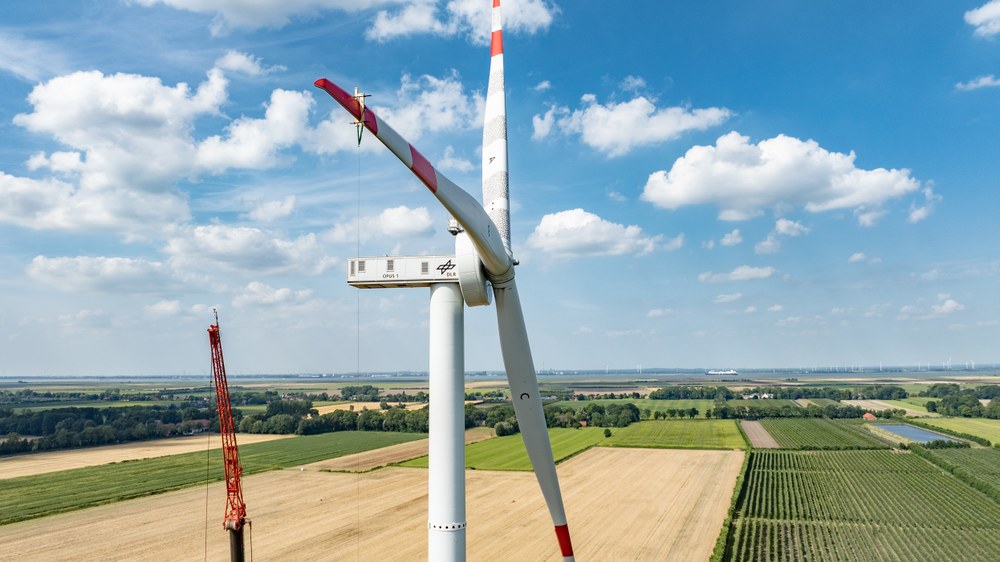DLR tests 'nervous system' of high-tech rotor blades



- The first tests have taken place at DLR's Wind Energy Research Farm in Krummendeich to setup and train the sensors on two wind turbines.
- To do this, the test team pulled on the rotor blades at various points using a cable.
- As soon as the sensors are fully set up, they will provide unique data on the loads acting on the rotor blades during operation.
- Focus: Energy, wind energy research
With the WiValdi Wind Energy Research Farm, the German Aerospace Center (Deutsches Zentrum für Luft- und Raumfahrt; DLR) has, since August 2023, operated a unique large-scale research facility in Krummendeich, Lower Saxony. The farm enables full-scale scientific research under real-world conditions. The aim is to gain a better understanding of wind energy and all its influencing factors, thus making the technology more efficient, economical and quieter. It is for this reason that the research park is equipped with more than 2000 sensors located in the two wind turbines, on measuring masts and throughout the site.
The sensors directly in the rotor blades play an important role. A team from the DLR Institutes of Aeroelasticity and Lightweight Systems – together with researchers from the Leibniz Universität Hannover, which is part of the Center for Wind Energy Research ForWind – had already installed these sensors in the rotor blades during their production. In August 2024, the scientists comprehensively tested and trained these sensors for the first time, between the ground and their lofty heights. They were supported by the manufacturer of the two wind turbines, Enercon, and the Enercon research and development company Wobben Research and Development (WRD).
Sensors in the rotor blades: collecting data to calculate loads precisely
"You can think of the sensors as being like the human nervous system. They collect information and monitor the loads acting on the rotor blade," says Yves Govers from the DLR Institute of Aeroelasticity. When the wind hits the blades, they bend. Depending on the wind speed and the position of the rotor blade, this can be by several metres. At the same time, they also twist.
At the centre of the test were 'strain sensors'. These are distributed across five points over the rotor blades, which are approximately 57-metres-long and weigh almost 17 tonnes. In simple terms, strain sensors work like rubber bands that you pull and then let go of. "During the test, we pulled on the rotor blades with a specified load and measured how the strain gauges deformed. Only with this data can we calculate the load during operation," explains Yves Govers. "The test was therefore an important prerequisite for evaluating and understanding the permanently measured strain data and relating it to other measured variables. In technical jargon, we call this process calibration."
Even sensors must learn: pulling on the rotor blade for science
Govers and his team examined the rotor blades one after the other. First, they held the blades in a position horizontal to the ground. Then, in the basket of a crane, they went up to a height of around 90 metres to mount a wooden frame – the 'load scissors' – on the rotor blade. Ropes attached to the load scissors were pulled down with a rope hoist. Step by step, the researchers increased the load up to a maximum of approximately one tonne – roughly the weight of a small car. They performed this procedure five times with each rotor blade. The ropes were also attached to different points on the load scissors to simulate the twisting of the blades.
The Institute of Turbomachinery and Fluid Dynamics at the University of Hannover conducted further measurements from the ground. Using special cameras, they observed how the blade deformed when bearing a load. To do this, the researchers used the many black measuring points on the surface of the rotor blades.
"This test was the first of its kind in such a highly instrumented research facility. The sensors worked very well and provided high-quality data. The transmission of the data to the control centre, which is positioned several hundred metres away and stores and processes all the data from the research park, also worked seamlessly,” summarises DLR expert Govers. Over the next few months, the focus will be on evaluating the data. This data will be used by the researchers to develop a calibration procedure that can then be used repeatedly to adjust the sensors.
The information provided by the sensory nervous system of the WiValdi Wind Energy Research Farm will create a unique and highly precise data collection for science and industry. In the future, this should make it possible to develop lighter, more efficient and longer-lasting rotor blades and to better plan and operate wind turbines and wind farms. At the same time, this data can be used to check and further develop simulation models.
The 'wake effect' is particularly interesting in this context: referring to the effect of a wind turbine on the turbines behind it. This is because the first turbine stirs up the wind before it reaches the next turbines. Turbines in the wake are therefore subject to different loads, which can affect their efficiency and material wear. For this reason, the two wind turbines in Krummendeich are located directly behind each other.
This research is being conducted under the 7th Energy Research Programme as part of the DFWind Phase 2 project funded by the Federal Ministry for Economic Affairs and Climate Protection (BMWK).

©BMWK, NMWK
Related links
- Featured topic: Wind energy research
- Krumendeich Research Wind Farm WiValdi
- DLR Wind Energy Experiments
- DLR Institute of Aeroelasticity
- DLR Institute of Lightweight Systems
- ForWind – Zentrum für Windenergieforschung
- Leibniz Universität Hannover website
- Enercon website
- Institute of Turbomachinery and Fluid Dynamics
- DLR opens wind energy research farm in Krummendeich
- Tomorrow's wind energy research – "We need to better understand the entire system"
- First two turbines at the DLR research wind farm assembled
- Bending and twisting – testing high-tech rotor blades
- 1500 sensors for the rotor blades of the future
About the DLR WiValdi Wind Energy Research Farm
The Wind Energy Experiments facility at DLR's Braunschweig site operates the WiValdi wind energy research farm. It also coordinates wind energy research at DLR, with contributions from the DLR Institutes of Aerodynamics and Flow Technology, Aeroelasticity, Flight Systems, Atmospheric Physics and Lightweight Systems.
DLR developed and built the research farm together with its partners in the Research Alliance Wind Energy (Forschungsverbund Windenergie; FVWE). The FVWE combines the expertise of approximately 600 researchers to drive forward the energy supply of the future. It consists of three participating institutions: DLR, ForWind – the joint center for wind energy research from the Universities of Oldenburg, Hannover and Bremen – and the Fraunhofer Institute for Wind Energy Systems (IWES).
WiValdi will be available to the broader science and industry research community for joint projects once the trial operations have been completed.
